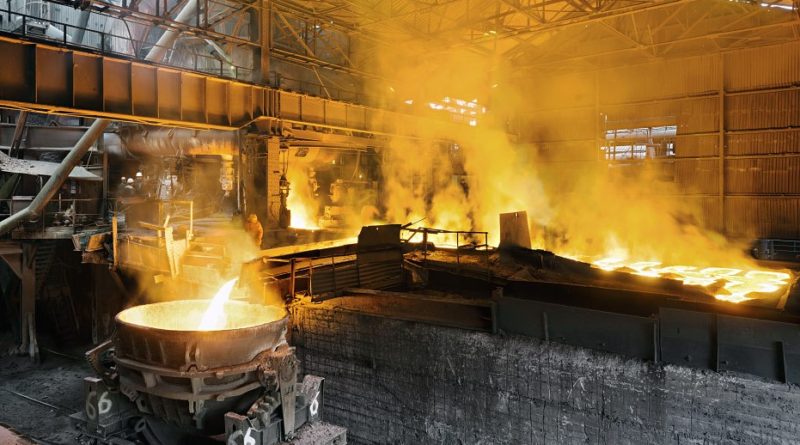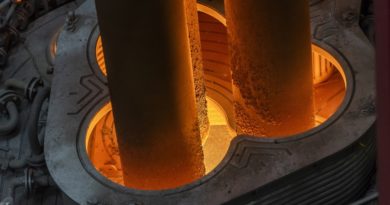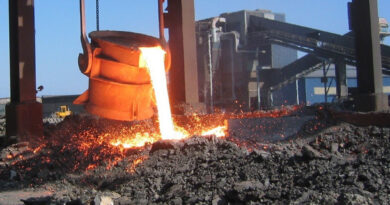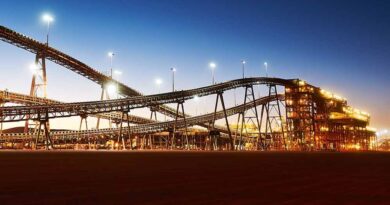Ferrochrome required for stainless steel production
Corrosion resistance is achieved by using chromium as an alloying element. In oxidizing conditions, a thin yet dense layer is formed on the surface of the metal if the chromium content of the metal is over approximately 12 w-% (e.g. Wranglén, 1985). This layer passivates the metal and prevents corrosion in several corrosive media.
In addition to chromium – whose content may vary from 12 w-% to nearly 30 w-% – stainless steels also contain other alloying elements that are used to adjust the structure as well as physical and chemical properties of the final product. The most commonly used grades of stainless steels are austenitic steels in which nickel is a third major component in addition to iron and chromium. Other major stainless steel categories are ferritic stainless steels (no nickel), martensitic stainless steels (less chromium in comparison to e.g. austenitic grades), and duplex steels (more chromium, some nickel). Additionally, some other elements are used in certain grades to enhance certain critical properties (e.g. molybdenum to enhance the corrosion resistance against acids) or to stabilize a certain structure (e.g. manganese to replace nickel as austenite stabilizer).
Since all stainless steels contain chromium, it is necessary either to alloy chromium or to use chromium-containing raw materials (e.g. ferrochrome and stainless steel scrap) in the production of stainless steels. From an economic point of view, the latter option is more suitable than the former. Concerning these raw materials mentioned above, ferrochrome is usually produced from chromite ores and concentrates, in which both of the stainless steel’s main components – i.e. iron and chromium – are present. Since the occurrence – and hence also the availability – of these raw materials is globally rather limited (Riekkola-Vanhanen, 1999), the use of internal and/or recycled merchant stainless steel scrap as a raw material is essential in the production of stainless steels. For instance, in 2010 over 5 million metric tons of stainless steel scrap were exported worldwide (ISSF, 2011b) and it is estimated that the average content of recycled material in new stainless steel is over 60 % (ISSF, 2011c). The end-of-life recycling rate of stainless steel is approximately 70 % (Reck et al., 2010).
Production of ferrochrome and stainless steel
As it was mentioned above, stainless steels are solutions of iron and chromium as well as other alloying elements that are used in order to obtain wanted chemical and mechanical properties for the final products. In the production of these highly alloyed steels it is important to utilize processes in which the yields of the valuable elements – such as chromium – are as high as possible. For the unit operations in which undesirable elements – such as carbon, silicon, or sulphur – are to be removed, this obviously sets certain challenges that are not encountered in the production of low-alloyed steels. Taking decarburization as an example, it is necessary not only to decrease the amount of carbon to a required level but to prevent excessive oxidation of chromium at the same time. This means that although there are certain similarities in the production routes of stainless and low-alloyed steels, some unit operations – such as decarburization mentioned above – are usually executed using a different kind of process solutions in comparison to low-alloyed steelmaking.
One of the key issues in the production of stainless steels is in fact to solve how to execute this decarburization without the simultaneous oxidation of chromium; i.e. how to promote the oxidation reaction of carbon and to prevent the oxidation reaction of chromium.
In order to do this, it is possible either to dilute the gas by blowing inert gases such as nitrogen and/or argon into the system or to decrease the total pressure of the system. The former method is used in AOD converters (Argon Oxygen Decarburization), whereas the latter is utilized in VOD converters (Vacuum Oxygen Decarburization).
In order to properly execute the decarburization, either AOD or VOD converter is used in nearly all stainless steel production routes. The AOD converter is more commonly used as approximately three-quarters of the stainless steel world production is manufactured using an AOD.
On the other hand, the charge sizes of the VOD converter are usually smaller than the ones of the AOD, and therefore it is often used in the steelworks in which the annual production is smaller.
Evidently stainless steel production consists of several other unit operations in addition to AOD (or VOD). These other processes are chosen based on the steel grades that are being produced as well as the raw materials that are being used. In the scrap-based stainless steelmaking, electric arc furnace (EAF) is used to melt the scrap, after which the molten metal is further processed in AOD, VOD and/or various ladle treatments depending on the requirements set by the product. In other words, the melting of the material and the metallurgical processing (i.e. mainly decarburization) are separated from one another into two independent processes.
If ferrochrome is used as raw material, it is also melted in the EAF, unless the production of ferrochrome is located in the same area, which enables the transfer of molten material from the ferrochrome plant to the stainless steel plant. As for ferrochrome, it is most commonly produced in submerged arc furnaces (SAF) using chromite ores and/or concentrates as raw materials. A so-called (ferro)chrome converter (CRK) can also be used as a pretreatment process between SAF and AOD, if ferrochrome is transferred to a stainless steel plant in a molten state.
The AOD (or VOD) is followed by e.g. ladle treatments, continuous casting, slab grinding, hot and cold rolling as well as pickling and annealing. However, these processes are omitted in this study, since the focus is on the refining processes preceding these operations.




